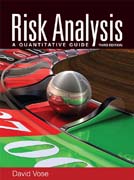
This book concerns itself with the quantification of risk, the modeling of identified risks and how to make decisions from those models. Quantitative risk analysis (QRA) using Monte Carlo simulation offers a powerful and precise method for dealing with the uncertainty and variability of a problem. By providingthe building blocks the author guides the reader through the necessary steps to produce an accurate risk analysis model and offers general and specific techniques to cope with most modeling problems. A wide range of solved problems is used to illustrate these techniques and how they can be used together to solve otherwise complex problems. INDICE: PART 1. Introduction. Chapter 1: Why do a risk analysis? Chapter 2: Planning a risk analysis. Chapter 3: The quality of a risk analysis. Chapter4: Choice of model structure. Chapter 5: Understanding and using the results of a risk analysis. PART 2. Introduction. Chapter 6: Probability Mathematics and Simulation. Chapter 7: Building and running a model. Chapter 8: Some basic random processes. Chapter 9: Data and statistics. Chapter 10: Fitting distributions to data. Chapter 11: Sums of random variables. Chapter 12: Forecasting with uncertainty. Chapter 13: Modelling correlation and dependencies. Chapter 14: Eliciting from expert opinion. Chapter 15: Testing and modelling causal relationships. Chapter 16: Optimisation in risk analysis. Chapter 17: Checking and validating a model. Chapter 18: Discounted cashflow modelling. Chapter 19: Project risk analysis. Chapter 20: Insurance and finance risk analysis modelling. Chapter 21: Microbial food safety risk assessment. Chapter 22: Animal import risk assessment. APPENDIXES. Appendix I: Guide for lecturers. Appendix II: About ModelRisk. Appendix III: A compendium of distributions. Appendix IV: Further reading. Appendix V: About Vose Consulting. REFERENCES.
- ISBN: 978-0-470-51284-5
- Editorial: John Wiley & Sons
- Encuadernacion: Cartoné
- Páginas: 752
- Fecha Publicación: 07/03/2008
- Nº Volúmenes: 1
- Idioma: Inglés
